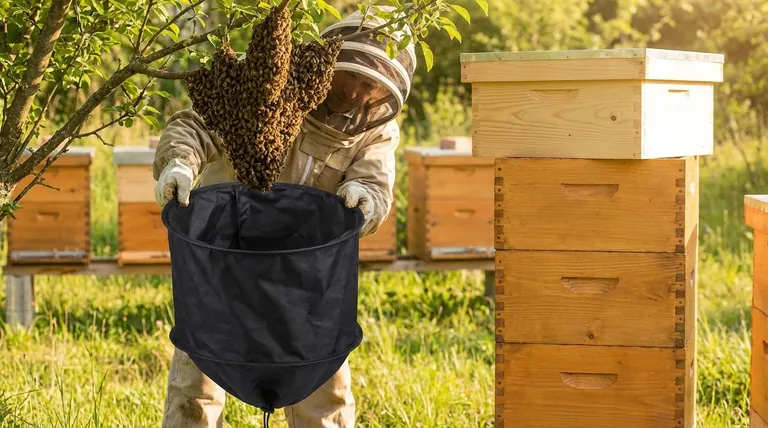To prevent a bee colony from leaving your hive, you must address the two distinct behaviors that cause this: swarming and absconding. Preventing swarming involves proactively managing space to accommodate a growing population, while preventing absconding requires maintaining a low-stress environment free from significant pest pressure or resource shortages. These are separate issues that demand different solutions.
While both swarming and absconding result in losing bees, they are fundamentally different events. Swarming is a natural reproductive act driven by a colony's success and strength, while absconding is a survival tactic driven by a colony's failure and extreme stress. Understanding this distinction is the key to applying the correct management technique.

Understanding Swarming: A Sign of Strength
Swarming is the natural way a honey bee colony reproduces. It is not a sign of failure on the beekeeper's part but rather an indication that the colony is thriving and has run out of space.
The Core Trigger: Overcrowding
When a hive becomes too congested, the queen has no more room to lay eggs and the workers have no more space to store nectar and pollen. This lack of space is the primary signal for the colony to initiate the swarming process.
The Telltale Sign: Swarm Cells
Weeks before they swarm, the worker bees will begin to build special queen cells, known as swarm cells. These are peanut-shaped cells, typically found along the bottom edges of the frames, where new queens are raised. The presence of these cells is a definitive sign that the colony is preparing to swarm.
How to Manage the Swarming Impulse
To reduce the urge to swarm, you must convince the bees that they have ample room.
- Add More Space: The simplest method is to add another hive box (a "super") on top of the existing ones. This provides more room for both brood-rearing and food storage.
- Split the Hive: An effective technique is to intentionally divide one strong colony into two weaker ones. This mimics the natural swarm process but allows you to keep all the bees.
- Remove Swarm Cells: During your inspection, if you find swarm cells, you can gently remove them. This is a temporary solution that can delay swarming, but it does not solve the underlying issue of overcrowding.
Understanding Absconding: A Cry for Help
Absconding is an act of desperation. Unlike swarming, where half the colony stays behind, absconding involves the entire colony abandoning the hive. They leave behind empty comb and sometimes a small amount of brood, but they take all the bees.
The Core Trigger: Unmanageable Stress
A colony will only abscond when conditions in the hive become so intolerable that they believe their chances of survival are better elsewhere. This is a last-resort survival mechanism.
Common Causes of Hive Stress
The key to preventing absconding is to identify and mitigate sources of stress.
- Pest and Disease Pressure: The most common cause is a high infestation of pests, particularly Varroa mites or small hive beetles. These pests weaken the colony and spread disease, making the hive environment untenable.
- Lack of Food or Water: A colony with insufficient honey stores and no incoming nectar (a dearth) may abscond to find a more resource-rich location.
- Frequent Disturbances: Over-inspecting the hive, especially during critical periods, can cause significant stress that may lead a colony to leave.
Common Pitfalls in Hive Management
Even with good intentions, beekeepers can make mistakes that encourage a colony to leave. Being aware of these common pitfalls is critical for success.
Misdiagnosing the Problem
The most significant error is confusing swarming preparations with signs of absconding. Adding more space to a hive that is suffering from a severe mite infestation will do nothing to prevent it from absconding.
Intervening Too Little
Ignoring the early signs of a problem is a common mistake. Failing to treat for Varroa mites or not adding a super when a hive is clearly packed with bees are passive decisions that can directly lead to colony loss.
Intervening Too Much
Conversely, inspecting your hive too frequently can be just as detrimental. Each inspection disrupts the colony's work, stresses the queen, and can damage the hive's delicate social structure. A calm, consistent, and purposeful inspection schedule is best.
Making the Right Choice for Your Colony
Your management strategy should be guided by a clear understanding of your colony's current state and your primary goals as a beekeeper.
- If your primary focus is preventing colony loss: Regularly inspect for both swarm cells (overcrowding) and signs of stress like high pest loads.
- If your primary focus is maximizing honey production: Proactively manage space by adding supers before the hive becomes crowded to keep the workforce focused on foraging, not swarming.
- If you are a new beekeeper: Prioritize a consistent and effective pest management plan, as a colony collapsing from stress is a far greater risk than one swarming from strength.
By reading your colony's signals and responding to its needs, you can foster a stable, healthy, and productive hive for years to come.
Summary Table:
| Behavior | Trigger | Goal | Key Prevention Strategy |
|---|---|---|---|
| Swarming | Overcrowding & Success | Natural Reproduction | Proactively add space (supers) or split the hive |
| Absconding | Extreme Stress (Pests, Starvation) | Survival | Maintain low-stress environment, manage pests, ensure food/water |
Don't let preventable issues cost you your colony. A stable, productive apiary starts with the right equipment and management strategies. At HONESTBEE, we supply commercial apiaries and beekeeping equipment distributors with the durable, high-quality supplies needed to manage hive health effectively and prevent losses.
Ready to build a more resilient operation? Contact our team today to discuss your wholesale needs and how our equipment can support your success.
Visual Guide

Related Products
- HONESTBEE Collapsible Tiered Bee Swarm Catcher for Beekeeping
- Professional Insulated Plastic Bee Hives
- HONESTBEE Professional Long Handled Hive Tool with Precision Cutting Blade
- Plastic Transporting Bee Packages and Nuc Boxes for Beekeeping
- Twin Queen Styrofoam Honey Bee Nucs Mating and Breeding Box
People Also Ask
- How to attract bees to a bee box? Create an Irresistible Home for Honey Bee Swarms
- What is the typical method for moving a swarm of bees? Capture the Queen for a Safe & Easy Transfer
- What information should be gathered before attempting to catch a swarm of bees? A Safe and Successful Guide
- What do beekeepers use to attract bees? Master Swarm Capture & Hive Management
- Can a nuc box be used for swarm catching? An Effective and Manageable Solution for Beekeepers



















